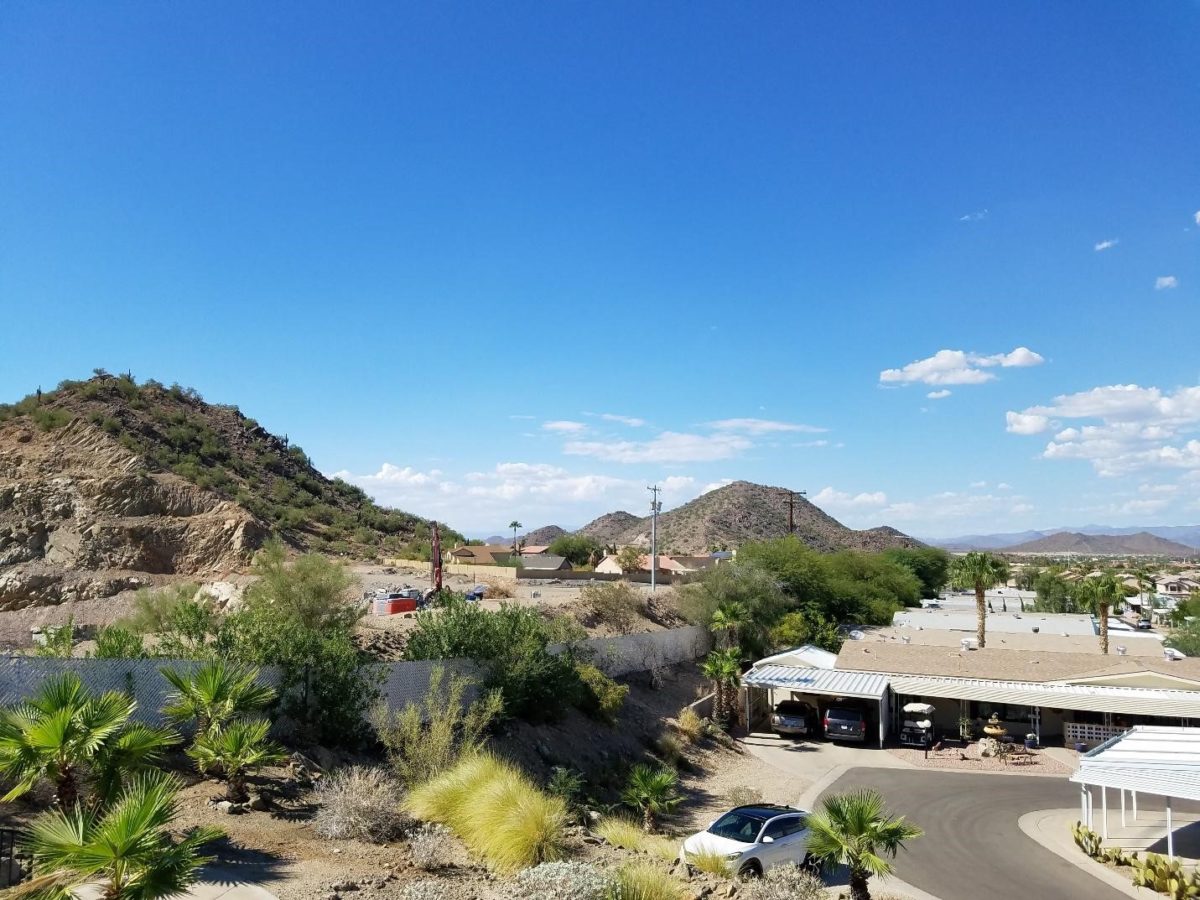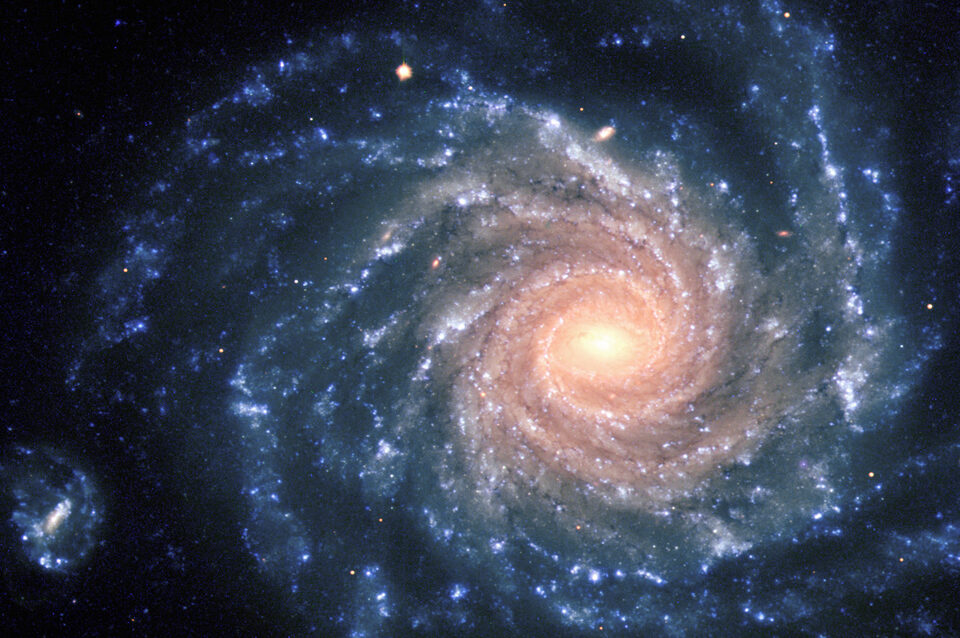This article was originally published by SciStarter on February 4, 2019.
By Margaret Hinrichs
In early 2018, Scistarter and Arizona State University began the process of collaborating with a local community, Boulder Ridge, to measure the quality of its air. Boulder Ridge is a 55 and older retirement community in Phoenix. Over the past three years, Boulder Ridge residents began to notice increased blasting, crushing, and trucking out of rock and dirt from an open stone mine next door operated by Southwest Rock Products, LLC. On days when there were no blasts or trucks, the residents noted significantly less dust in the air and on their cars and houses. However, they felt they had no way to scientifically test and validate whether the air quality changed as a result of the mine’s activities.
In the months that followed, several Boulder Ridge community members and researchers at SciStarter and Arizona State University initiated a collaborative process of evaluating the availability and usability of low-cost air quality sensors. The SciStarter tools database (in development) provided a ready and accessible list from which to choose air quality sensors which might fit the needs of the Boulder Ridge community, and researchers from ASU coordinated with community members on the installation and maintenance of the sensors themselves. Scott Ericksen, a recent graduate from Arizona State University School of Energy Matter and Transport Engineering with a Masters degree in Chemical Engineering, acted as the technology support leader for the project by providing hands on support for the sensor use as well as helping publish tool reviews for the sensors on the SciStarter tool database. From a technical perspective and with leadership from Scott, the goals behind this collaboration were to A) demonstrate and document the process of validating low-cost air quality sensors against credible reference monitors, B) work with community members on how to access and install their own air quality sensors, C) collaborate with community members on how to interpret data outputs produced by the sensors, and D) use the process and outcomes to inform the design and development of the SciStarter Tools Database.
As the project progressed, the research team realized there was an additional opportunity to learn about approaches to citizen science and improve the participatory process of community engagement. The team filed an application with the ASU Institutional Review Board (IRB) and began interviewing community members about their experiences communicating with the university and their understanding of the goals of citizen science. In addition to assessing the sensor technology, this social component highlighted the need to also understand the human element in scientific collaboration and community-university partnerships.
Assessment of airborne particulate matter
Particulate Matter (PM) is a common form of air pollution which arises from several different emission sources. PM is closely regulated in the United States by the United States Environmental Protection Agency (USEPA), according to the National Ambient Air Quality Standards (NAAQS). PM is based on the diameter of particle sizes, and is broken into the groups of PM2.5 and PM10. PM2.5 refers to all particulate matter which is suspended in the air, having a particle diameter of 2.5 microns or smaller. PM10 refers to all particulate matter which is suspended in the air, having a particle diameter of 10 microns or smaller. Figure 3 provides a visual aid in understanding the differences in these PM groups, as well as how these particles correspond to more understandable physical item diameters, such as an average human hair or an average grain of sand.

At Boulder Ridge, the sensors being used only measure the amount, or concentration, of PM present in the air at a given time. Collaborators from ASU and SciStarter, led by a panel of independent advisors from the EPA, Clean Air North Carolina, and Sonoma Technologies selected air quality sensors for testing based on a set of criteria including:
- Low-cost ($350 or less)
- Practicality, usability, and low-maintenance
- Ability to measure and record data for Particulate Matter (PM) 2.5 and 10
Air quality sensor installation and validation
Several air quality sensors were considered for inclusion in this study and a number made it to the installation and testing stage. However, based on the criteria above the research team selected PurpleAir, AirBeam2, and Clarity as the final air quality sensors for comparison. These three sensors were compared to the Arizona Department of Environmental Quality’s (ADEQ) reference monitors in South Phoenix, which are official, EPA-caliber PM sensors. The research team installed the three sensors next to the ADEQ reference monitor site for output comparison.

Throughout the summer months and into the fall, the research team conducted a series of experiments between Boulder Ridge and the reference monitor site in South Phoenix to determine which of the sensors was best suited to the needs and environment of Boulder Ridge. These experiments examined the use of different operating systems required by sensor software, the use of wifi hotspots to support data transmission, the use of external hard drives to store data after it was collected by the sensor, physical placement of the sensors within a three-sided box or open air environment, height of the sensors from the ground, and in the case of Boulder Ridge, distance of the sensors from the mine itself. Whereas initial placement at Boulder Ridge was in the backyard of a resident close to the road leading from the mine to the street, the sensors were eventually moved up to the tennis courts for better data collection. The step-by-step process describing this agile approach to validate low cost sensors and reviews of each sensor has been documented and will be posted on this blog. Each review is linked to the sensor record on the SciStarter tools database. The database aims to help three audiences: scientists seeking validated, low-cost sensors; makers and manufacturers seeking to make their sensors discoverable; and citizen scientists seeking the right tool based on intended use.
In summary
- Though PurpleAir was easy to set up, required little maintenance, and has more of a trusted reputation given its successful use in North Carolina, it eventually proved to have wifi connection issues and became disconnected in November without apparent cause. [Editor’s note: Purple Air issued a Safety Recall Notice because its power supply was reported to spark or smoke. The unit installed at Boulder Ridge turned out to be defective and stopped reporting data last week.]
- AirBeam2 proved to be the sensor with highest maintenance costs, requiring an Android operating platform, strong wifi network, cellular data plan, and a preloaded app. It also had power issues. Despite being connected to continuous power, the unit died and would not turn on once inspected.
- The Clarity Node appeared to be the best performer of the three, providing an intuitive user interface and easy to read data outputs. However, the Clarity sensor required a $600 annual subscription to access data once it was collected. This technically violates the “low cost” criteria outlined above, though the subscription cost was discovered after procurement.

Social implications of citizen science and air quality
In addition to providing lessons learned about the three air quality sensors tested at Boulder Ridge and the South Phoenix reference point, this collaboration also yielded insights regarding the social process of collaborating with communities. The research team interviewed 13 Boulder Ridge residents about what brought them to Boulder Ridge, their experience living next to the mine, their conceptualizations of citizen science, and their hopes for the collaboration with SciStarter and ASU.
A clear pattern which emerged in the interviews was that residents did not know what was meant by “citizen science.” Proposed definitions included:
- Citizens joining existing projects in universities to learn about interesting topics
- Universities and scientists working with communities to figure out what their need is, to work with them, and help them out
- Giving non-academic people an opportunity to be more about the world and things that are important
Of particular concern among some community members was the issue of continuity regarding the ASU and SciStarter research team. One member voiced concern that “two years ago it was someone else, now it’s you. Can you guarantee that two years from now you’ll still be here, or will it be someone else?” The research team emphasized that the goal of the project was to help the community learn to install, operate, and understand sensor data output on their own without continued reliance on university staff or resources. Thus, expectation management and clarification of roles and responsibilities became a key component of these engagements.
To clarify the intent and scope of involvement for SciStarter and ASU, the research team drafted an insert for inclusion in the monthly Boulder Ridge newsletter. For the most part, the research team coordinated community site visits and interviews through specific residents as the primary community contacts. The newsletter insert was an attempt by the research team to communicate a consistent message to the community as a whole.

In December 2018, the research team visited Boulder Ridge as a group to give updates on sensor testing and answer any questions residents had about the progress thus far (Figure 6). The team shared the results of the ongoing air quality sensor experiments and distributed a pamphlet to attendees defining particulate matter, outlining the scope of the entire project, describing each of the sensors in detail and including some preliminary graphical outputs of data collected by each of the three sensors described above. The team again sought to manage expectations for further involvement, reiterating that the big picture goal of the project was that the community would be self-sustaining in regard to data collection, interpretation and use of the data to communicate their needs to city council, environmental groups, and health and human services, if necessary.
Key takeaways
Both the technical and social components of the study described here reveal important recommendations for future collaboration between research entities and communities in regard to air quality assessment.
First, it is important that research collaborators’ sensor selection criteria be informed by existing community constraints. In this pilot project, the research team and advisor panel selected sensors according to cost, measurement of PM, and perceived usability. However, once the validation and installation process began in conjunction with the community other criteria were identified of equal, if not higher importance. These included the limitations of sensors using a specific operating system, as well as dependence on wifi and need for a constant computer connection for downloading and storing data. Community members’ localized knowledge of their residential area could have helped inform the sensor selection criteria established by the research team and advisors.
Second, the data outputs of air quality sensors are only useful insofar as community members can interpret and understand them. Particularly if community members are not part of the sensor selection process, they will not be familiar with the physical sensor itself or the technical reports resulting from data collection. Even if community members are able to select, purchase, install, and collect data from an air quality sensor, it is recommended that they work with a local university or regulator (county Air Quality Department, for example, or the local Health and Human Services department) to help them interpret the data output and communicate about the data’s implications, as well as decide if they can or should expand data collection to other materials or substances.
Lastly, we recommend that communities share concerns regarding data collection and validity with their local air quality department, as well as additional phenomena which they believe might contribute to but not be reflected in measurements of air quality. While the air sensors included in this study measured the amount of PM in the air, they did not reflect the quality of life impacted by noise, ground shaking, blasting, and the frequency of trucks traveling on a side road in and out of the mine. Community residents recorded all of these data points so when we connected them with the regulatory agency (AZ State Department of Environmental Protection), their concerns were informed and taken seriously. By connecting with a local regulating agency or air quality department, communities gain the chance to make their voices heard and create a more holistic story of their experiences.
Future directions for air quality testing
The sensors included in this project assessed the concentration of PM in the air. They do not identify the source or chemical makeup of the particles which are counted. The technical scope of this project focused on the general air quality of the location measured in terms of particle matter in the air, not the composition of the particle matter. This is an important first step for Boulder Ridge in determining whether or not a content analysis of the PM may be necessary. Future tests may be required to assess the amount of certain chemicals and components of the particulate matter.
Once the sensors have collected more data, the team will have one final meeting with community members about how to collect, store, and read graph outputs. Community members said they will begin a log tracking all of the blasts so that they can compare dates and times to the sensor output graphs once data outputs are ready.
The research team also reached out to some of the mine and Arizona Department of Environmental Quality (ADEQ) officials to include their perspectives within the scope of what is happening at Boulder Ridge and their experiences interacting with the community. Officials from ADEQ were very responsive and offered to meet with the community and the mine officials. Until this project, the ADEQ officials the research team spoke with did not know about the excessive noise disturbances from blasting, increased truck and dust activity, or the community’s desire for testing of heavy metals in the dust from the mine. More often than not, what communities like Boulder Ridge have to deal with is a bad zoning issue, according to ADEQ. Cities such as Phoenix which experience residential expansion often find residential areas being developed next to industrial-zoned land, and though mines and smelters may be operating in compliance the effects of their operations on noise, smell, and ground disturbances often prove to be a nuisance for their neighbors.
The team plans to do exit interviews with community members once the sensors and their maintenance is officially handed off to the community, to capture lessons learned and any other thoughts on best practices for other community-university partnerships moving forward. This hand off is anticipated to occur in March 2019.
Acknowledgements
This project was supported by a Schmidt Futures grant, which seeks to advance society through technology, inspire breakthroughs in scientific knowledge, and promote shared prosperity.
Scott Eriksen acted as the technology support leader for the project by providing hands-on support for the sensor use in SciStarter-ASU operations, as well as helping publish tool reviews for the sensors on the SciStarter tool database.
Special thanks as well to Emma Giles and Alyssa Henning, two student research assistants who supported the technical and social components of this study.
The reports and input from the advisors and community residents have been used to inform the design and development of the SciStarter Tools Database. Our hope is this will all help other people more easily find the right tool, based on intended use and other criteria, and ultimately improve data quality and related follow up actions.
About the Author

Margaret Hinrichs is a postdoctoral research associate in the School for the Future of Innovation in Society at Arizona State University. She served as an advisor to the students conducting the social science components of the air quality sensor project described above. She is also a project manager for ASU’s Decision Theater, where she supports engagement between the university and the communities which it serves.




